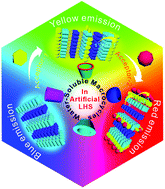Artificial light-harvesting systems based on macrocycle-assisted supramolecular assembly in aqueous media
Abstract
Light-harvesting, which involves the conversion of sunlight into chemical energy by natural systems such as plants, bacteria, is one of the most universal routine activities in nature. Thus far, various artificial light-harvesting systems (LHSs) have been fabricated toward solar energy utilization through mimicking natural photosynthesis in simplified and altered ways. Macrocycles are supramolecular hosts with unique cavities, in which specific guest molecules can be recognized based on non-covalent interactions. They have been widely employed in constructing LHSs due to their ability to form supramolecular assembly and dynamic molecular activity. In this review, we mainly focus on some representative examples reported by our group and other groups. Specifically, the fabrication of LHSs and their related discussions, such as a high donor/acceptor ratio, driving force for the formation of supramolecular assemblies and energy transfer mechanisms using different water-soluble macrocycles such as cyclodextrins (CD), pillararenes (PA), calixarenes (CA), cucurbiturils (CB), and other macrocycles will be included. In addition, how the resulting supramolecular self-assembled LHSs could be potentially utilized for photocatalysis, sensing, and imaging is also explained in detail. Challenges and developing trends for photochemical solar energy conversion will also be presented.

- This article is part of the themed collections: Functional Supramolecular Photochemistry and Chemical Communications HOT articles


 Please wait while we load your content...
Please wait while we load your content...